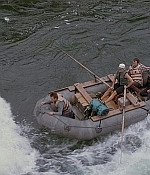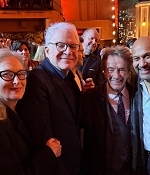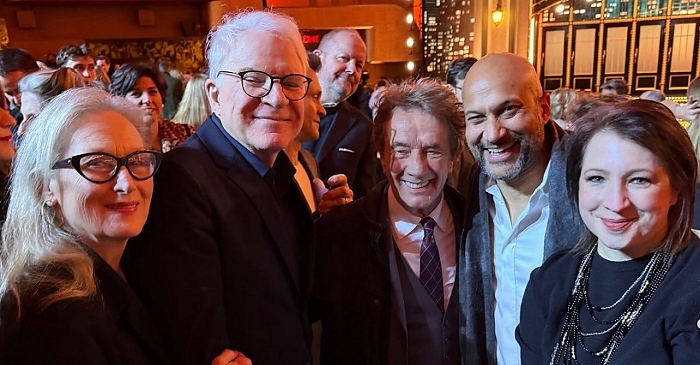
The River Wild
September 30, 1994
· Universal Pictures
· 108 minutes
|

A non-fiction article for “Fly, Rod & Reel” Magazine by fly-fishing aficionado Deni O’Neill served as the inspiration for “The River Wild”. The piece was based on a fishing trip O’Neill took down Montana’s Smith River, notable not only because “it is beautiful and remote”, but also because once you get on that river, you can’t get off”, says O’Neill. “You have to travel the length of it.” For producer David Foster, the screenplay for “The River Wild” was a chance to fulfill a long-time cherished ambition. In 1975, while developing a Western titled “Running the Wild Big Red”, a fictional account of the first trip down the Colorado River rapids, Foster acquired his enduring fascination for white-water river rafting. Although the project was set aside the Westerns fell out of favor, Foster kept the dream alive. “For 17 years, I’d wanted to do a movie set on the rapids”, says Foster. “When I read the first draft of ‘The River Wild’, I knew I had a project that could work. From the moment I read the original script, I had two people in mind for the movie – I wanted Meryl Streep to star in it, and I wanted Curtis Hanson to direct,” says Foster.
“In my years of producing, this was the first time I got my number one choices right off the bat.” Universal and Turman-Foster brought Curtis Hanson to the project early on in the development process. Because of Hanson’s proven talent to direct such thrillers as “The Bedroom Window” and “The Hand that Rocks the Cradle”, he seemed a natural choice for “The River Wild”. Streep and company got to know the river before the film’s official start date. Prior to principal photography, they enjoyed two weeks of what was affectionally dubbed “research and development”. The cast and director met in Grant’s Pass, Oregon for rehearsals on land and water. Not only did they interact as artists, they learned the dynamic of working together while maneuvering rafts down a river, in both placid and rough areas. These trip resulted in a deeper understanding and, sometimes, a redefinition of the characters. John Wasson, a rafter for over 25 years, consulted the shooting. “Meryl wound up doing 90 percent of the rapids by herself. For the dangerous waterfalls, we used a stunt double for reasons of safety – but Meryl would take the raft right up to the edge, and she took over again the moment the raft came through. She was an amazing trouper”.
There’s this one scene where I’m rowing at the foot of a pretty big waterfall in profile. I call it the Iwo Jima shot. And we did it over and over again because they were in love with this shot. So we did it all morning, and then in the afternoon, for dessert, we came back to do it again. But on the third time, I came down through the hole in the rapids, and the raft was thrown back. All of a sudden I was pulled back like there was a hook on my throat, and – free as a bird – I just went sailing out of the raft and under the bottom of it. And I don’t remember it at all. All I remember is coming out of the water about 500 yards down the river. But Curtis remembers it! Oh, he got it on film, definitely. And he had the nerve to ask me to do it again. (Meryl Streep, US Weekly, October 1994)
Producer Lawrence Turman commends Streep’s technical ability, noting that authenticity is key of the success of the movie, whiche he calls “one of the most exciting and daunting projects I’ve ever encountered.” “It’s one thing to say that Meryl Streep goes down the river, but in this script, she takes on some of the toughest rapids in the history of rapids,” says Turman.
Curtis Hanson has always been an expert for psychological thrillers, paired with strong female characters, such as his 1987 film “The Bedroom Window” and the 1991 thriller “The Hand that Rocks the Cradle”, in which he gave Rebecca De Mornay the role of a lifetime. “The River Wild” is less gritty and more family orientated, which serves the film well, despite some moments. The film boasts some amazing nature landscapes and wonderfully shot scenes, especially the rafting segments. The story is at times a bit far-fetched, but serves the cause of a solid action film. Which it is only on the surface. A great deal of the film centers on the family’s problems and their crumbling marriage. Throughout the film, the family learns to stick together and fight the evil, in this case the robberers. When the father is on the run and tries to save his family’s lives, with the help of the family dog, “The River Wild” reminds you that you’re watching a thriller that stays family-friendly throughout. But that doesn’t make the film any worse. It keeps its pace and serves believable characters that you’re rooting for. It’s also a nice change that the action hero is the mother. After “Death Becomes Her”, this has been another departure for Meryl Streep and she received her share of “Rambo” jokes by critics when the film was announced, but just like any other role she has played, Meryl immerses into her character, she takes the rapids like she hasn’t done anything before and becomes a lioness to save her family. The rest of the cast is equally good – but the star of the film is the cinematography. This is an enjoyable family thriller, suitable for everyone. Recommended.
☆ Screen Actors Guild Award – Best Actress
☆ Golden Globe Award – Best Actress














